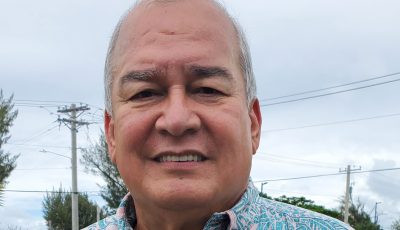War and some unusual developments regarding nuclear-related topics
Guam and the Northern Mariana Islands are one island chain that is embedded in the minds of Chinese military personnel who are charged with selecting and figuring out what adversary targets are most important to knock out, should China and the United States ever go to hot war.
Guam’s Andersen Air Force Base is a huge military threat to the Chinese and to the North Koreans and Russians. Andersen is one of the most important American military bases in the world. Andersen has one of the world’s largest petroleum, oil, and lubricant storage facilities, training facilities, and areas that store, manage, maintain and load ordnance and other weapons of war.
Andersen is located atop stolen Chamorro family lands located in our Deep Blue Pacific Ocean Marianas Trench continent. The U.S. Air Force is not formally required to ask permission to fly over foreign national airspace because from the American military perspective, we are close yet far enough away from any nation that requires the United States to first seek diplomatic approvals and notifications. This is one of the many benefits afforded the Pentagon and the Air Force by residing in Guam and the Marianas.
Guam’s Andersen Air Force Base is also the perfect location to store, manage, hold, and/or stage live nuclear missiles and weapons into and out of fighters, unmanned systems, and strategic aircraft that are assigned America’s nuclear bombing missions. These activities go relatively unnoticed because of our unique location. Missions can simply be initiated any day or night throughout the year.
But bombs are not the only thing that is on the nuclear discussion table these days
These days the Department of Defense is also moving forward with design plan options to construct and operationalize nuclear-powered micro-reactors, transportable on Air Force cargo planes, to be used as power generation sources for military bases in remote locations.
These nuclear reactors are intended to generate the power equivalent of up to 1% of a large commercial nuclear power plant once assembled and turned on. The huge problem with the idea of having a nuclear reactor power plant on a military base is that it may cause catastrophic damage to all human life in and around the immediate area despite official comments from the U.S. Army that there are several safety prevention measures being taken to address this concern.
One rationale that is being proposed to support the construction and design of nuclear reactors is that it will save over time millions of gallons of fossil fuel from being consumed, which is in line with environmental sustainability up to a point. Opposing viewpoints argue that there is simply no need to place a nuclear reactor in a remote military base because the amount of power generation it provides is not really needed because existing diesel-powered generators are adequate for use on remote military bases.
Nuclear reactor controversies are nothing new to the Pentagon and the Army
The Army previously had a nuclear reactor program that started during the time of the Korean war era, lasting up through the Vietnam war era. The program had mixed results, one catastrophic outcome, and was quite expensive to maintain. The current program under consideration is supported by the idea that having a small and mobile nuclear power plant for use by base personnel will also mitigate military casualty rates associated with the transportation and security protection of fuel in land-based warfighting areas. Supporters also point to the need for a constant source of power generation required for radars and for high-energy weapons.
So why should our Chamorro Pacific Islander Deep Blue Continent civilization be concerned about these developments?
The Pentagon and the Army have identified Guam as one of approximately 10 sites that are slated to have a micro nuclear reactor. The Marshall Islands is also another site identified to receive a nuclear reactor.
But what our Chamorro people should be aware, as well as the people of Micronesia, especially the Marshallese, is that it is the U.S. Congress, not the Pentagon, that has been the genesis behind the push to get the Pentagon funding to move forward on this micro-nuclear reactor effort. Why is this the case?
What the Guam and NMI congressmen need to do
Michael San Nicolas and Kilili Sablan have not articulated why Congress has been pushing the Pentagon to look into the design, construction, and use of small nuclear reactors for the Army.
Both congressmen have not publicly addressed the need for a multi-Mariana Islands nuclear bomb shelter infrastructure study nor has there been any effort by these congressional leaders to introduce authorization language addressing this huge human health, readiness, and life or death safety issue tied to the increased militarization of our Mariana Island chain.
President Biden will be the final authority as to whether a small mobile nuclear reactor program will proceed or be cancelled. These congressmen have not talked to President Biden about this very important matter.



























